This week I thought I’d tell another story from the era of King Charles II and reveal some more of the scandalous behaviour which went on at court.
King Charles II was known for his insatiable appetite with women. He had many mistresses and rarely one at a time but the lady whom I am going to speak of today was one who kept his interest for several years. She was Born Barbara Villiers she was the only child of the 2nd Viscount Grandison who died during in the Civil. His death left Barbara and her mother penniless as his lands were confiscated and all his money had been invested in supporting King Charles I. Her mother remarried, taking her father’s cousin as a husband, but they still had very little money. Yet they stayed loyal to the Royals and when King Charles was executed turned their allegiance to his son who was at the time in hiding in The Hague where the Stuart’s had retreated for safety, as I mentioned in my last blog.
There is a tale told about Barbara’s family that each year on Charles II’s birthday they crept down into their dark unlit cellar and toasted his health in secret. If this is true it would seem that his image was romanticised in Barbara’s eyes from an early age.
Barbara was described by diarists of the time as tall and voluptuous, with thick auburn hair and blue/violet eyes, her beauty was said to be striking. It was no wonder then that she traded on her looks from a young age when she had no dowry to commend her. The first man she is known to be romantically linked to is Philip Stanhope, 2nd Earl of Chesterfield but he wanted a wealthy wife and would not marry her. Barbara married Roger Palmer on 14th April 1659, before Philip Stanhope wed, and one rumour which abounds about her is that her first child was Chesterfield’s but this child was born during her affair with Charles II and Charles did acknowledge the child as his. It was only a year after her marriage that she became mistress to Charles II in 1660. He was still in exile in The Hague at the time. Barbara had sailed there with her husband who was a Catholic, to join the out-placed court of supplicants who still sought Royal favour.
It sounded as though Roger Palmer’s father had the measure of Barbara because he’d told Roger not to marry her and claimed she would make him one of the most miserable men in the world. They were living separately by 1662, despite Charles II favouring Roger for his wife’s generosity with two titles, Baron Limerick and Earl of Castlemaine.
Barbara bore Charles five children which he acknowledged.
- Lady Anne Palmer (who was later renamed Fitzroy) born 1661
- Charles Palmer (who was later renamed Fitzroy) born 1662
- Henry Fitzroy born 1663
- Charlotte Fitzroy born 1664
- George Fitzroy born 1665
- Barbara Fitzroy, the sixth child, was born in 1672 but Charles’s never actually acknowledged her
(The surname Fitzroy comes from the meaning son of the King)
Her period of greatest favour with the King was in 1662 when she gave birth to his son at Hampton Court, showing no desire to hide her child’s parentage, while the King was on his honeymoon. On his return he appointed her Lady of the Bedchamber to his wife, Catherine of Braganza. For obvious reasons his wife complained about it. She had fallen in love with Charles on honeymoon and was destroyed when she returned to find his lover encamped at Hampton Court. Why would she wish her husband’s mistress attending to her in her bedroom? It is well recorded that Charles frequently favoured Barbara over his wife, making a fool of Catherine and even arguing with her and tricking her into acknowledging his mistress while Barbara gloated over her influence. Charles’s interest in Barbara soon slackened after 1662 although clearly their affair continued as they had more children, and diarists of the time record the on off affair. But Charles’s favourite of 1663 was Frances Stuart, whom Barbara had on one occasion mockingly married for a joke. In this year Barbara converted to Catholicism. We can only guess at her reasons, but perhaps it was to try and regain the king’s favour.
In 1670, with Barbara’s affair with Charles drawing to a final close, as Barbara grew older and the king turned to younger lovers, Charles made her Baroness Nonsuch as she was the owner of Henry VIII’s Nonsuch Palace, he also named her Countess of Castlemaine and Duchess of Cleveland, unusually declaring her Dukedom of Cleveland would pass to her first son, Charles Fitzroy, on her death. All honours for favours served of course and perhaps parting gifts. This was the rumour running through the court at the time.
While King Charles II took lower status lovers, particularly thinking of the actress Nell Gwynne who is commonly romanticised as an orange seller. So did Barbara, building up a reputation for promiscuity. One of her lovers was an acrobat, Jacob Hall, and it was well known that her lovers benefited financial from her arrangements with them. Equally as Charles’s lovers got younger so did Barbara’s and she became quite the Cougar. Barbara Fitzroy, Barbara Palmers daughter, born in 1672, is believed to have been fathered by Barbara’s second cousin John Churchill who built Blenheim Palace when he was much older.
There is a mock-up of the court intrigues scenario in the upstairs rooms of Blenheim Palace if you visit there, with Barbara in the bed, the sheets covering her naked body, while John Churchill is hidden in the wardrobe as the King knocks on the bedroom door coming to his mistress. It is a true scenario although I think by this time the King probably cared very little what Barbara did and merely used her bed when he wished to. Barbara was also a lot older at the time than she is portrayed in this scene. The story at Blenheim indicates John seduced her and my guess would be it was the other way about. She may well have even deliberately timed the liaison to try and make the king Jealous. I think that would have been pointless too when Charles had his pick of beautiful woman at court and beyond. My assumption that Barbara seduced John is supported by the fact he benefited handsomely from the liaison, by the sum of £5,000 no less, which was a fortune at that time.
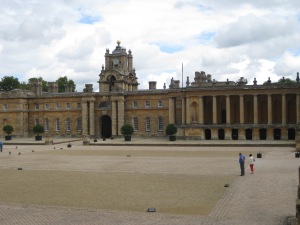
Blenheim Palace, called a palace as the land it’s built on was donated by the crown and is still owned by the Queen
What I find quite amusing though is that John must have favoured Barbara’s style of personality, it is said she was bad-tempered and dominant, but equally in her own brash way, the life of the party. John later married a woman of a very similar temper who most men could not get on with but he seemed to adore her. Again if you visit Blenheim they have a display about John’s wife and the sharp way with which she managed the architect and builders of Blenheim Palace while he made his name fighting wars abroad communicating regularly with her and they wrote to each other in very honest appraisal.
Certainly Barbara’s affair with the King was long over by 1676 when she went to Paris and lived there for four years with four of her children.
Like many women of history who spend their younger days living on their beauty through promiscuity the story of Barbara’s latter years grow much sadder as her looks fade.
After Charles’s death in 1685 Barbara had an affair with an actor who had a notorious reputation for using women. Barbara even bore him a child in 1686. In 1705 Barbara’s husband Roger Palmer died and then Barbara fell pray to a fortune hunter. By records of her later divorce this relationship was extremely tawdry and Barbara had tumbled to the lowest point of her life. The stories recorded at the time describe Barbara as lustful with a strong sexual appetite, and so when this young man paid her court she was very willing to take up with him and then marry him, believing him devoted. The only thing he was devoted to was her money. The man she married was Major General Robert “Beau” Fielding. He was known as “Beau” in recognition of his good looks and he was unscrupulous.
While Beau was married to Barbara he had two actresses as mistresses and not only them, when one of Barbara’s granddaughters fled to her dissipated grandmother for protection after her marriage failed due to an affair, Beau set up a relationship with the Barbara’s granddaughter too, in Barbara’s own home. Once this granddaughter left the house the affair continued for a few more months unknown to Barbara and the granddaughter bore Beau a child, although the affair had already ended by the time it was born.
This all came out in the end and was recorded in divorce records of the time and detailed in scandal columns as finally it came to light that not only did Beau have mistresses but he also already had a wife. He had bigamously married Barbara only to obtain access to her wealth. Barbara died at the age of 68 on 9th October 1709. What a sad bitter ending to her life when she had known so much earlier acclaim as King Charles II’s mistress. Barbara’s portrait still hangs in Hampton Court among the group of Ladies in Waiting King Charles II had painted by Sir Peter Lely. The pictures were known for being particularly risqué with a strong sexual indication and the image of Barbara has her bodice slack, so you might almost see her nipple, while her eyes are heavy-lidded in a come hither look and her left hand grips a sword.
To learn more of Barbara you can read Pepys diaries on the intranet. This link leads to the tale of the war between Barbara and Charles II’s wife recording how Barbara manipulates Charles into not only disgracing his wife but treating her with appalling cruelty.
The Marlow Intrigues

The Lost Love of Soldier ~ The Prequel
The Illicit Love of a Courtesan
The Secret Love of a Gentleman
Jane’s books can be ordered from booksellers in ebook or paperback
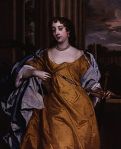
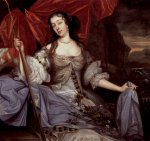
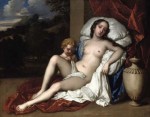

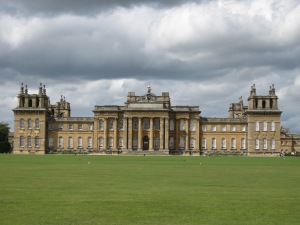
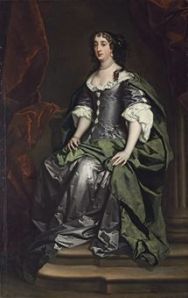
I don’t actually know why but I’ve always tended to prefer Charles II’s mistress to catherine of braganza…
Very interested in this, and came across it after I googled members of The Glenham family. I understand Anne Glenham and Paul Bayning were her grandparents. My mother’s maiden name was Glenham and I already knew they were Landed Gentry,as my uncle did some research years ago. Fascinated to see how interconnected the family were to many prominent families over several hundred years. The Glenham families are no longer gentry, and my particular line ended up in London’s East End.
🙂 I’d love to have landed gentry in my past – not found any yet, though. My 17th Century relation sold ale and had four illegitimate children. We get stuck after that.
This sad lady – Barbara Villiers – just so happens to be my 7Xgreat grandmother through illegitimacy by her daughter Barbara FitzRoy with Lt. General James Douglas, 4th Duke of Hamilton and their son Charles Hamilton, “styled” Earl of Arrans, 1691-1754. Alas, I am descended from the Stuarts, so that kicks me out of the line of succession real quick for good reason too, for I am old and ugly compared to the handsome boys of Prince William and Prince Harry both born from a gorgeous mother in Princess Diana Spencer. Thank God they didn’t inherit any traits from ugly old horse face Prince of Wales Charles.
😀